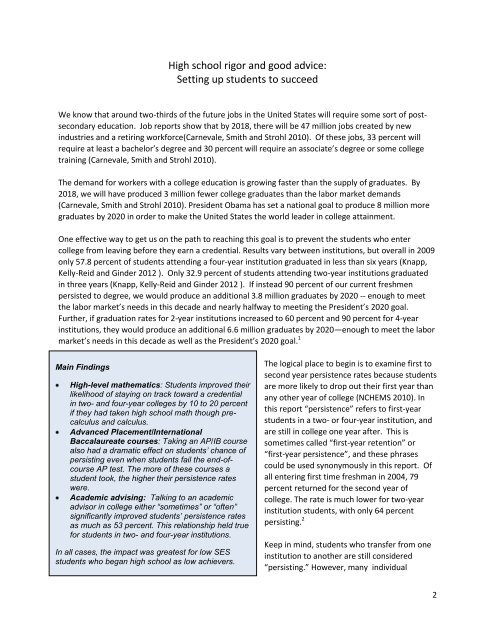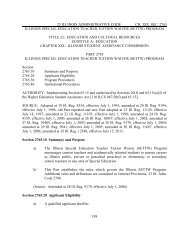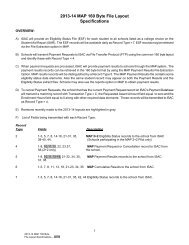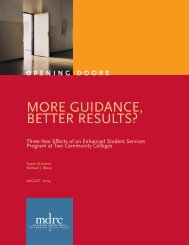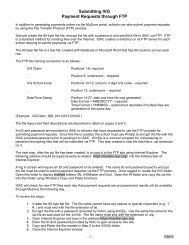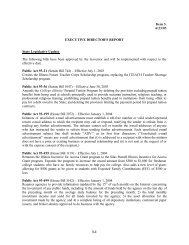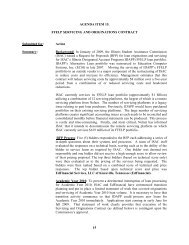High school rigor and good advice: Setting up students to succeed
High school rigor and good advice: Setting up students to succeed
High school rigor and good advice: Setting up students to succeed
You also want an ePaper? Increase the reach of your titles
YUMPU automatically turns print PDFs into web optimized ePapers that Google loves.
<strong>High</strong> <strong>school</strong> <strong>rigor</strong> <strong>and</strong> <strong>good</strong> <strong>advice</strong>:<br />
<strong>Setting</strong> <strong>up</strong> <strong>students</strong> <strong>to</strong> <strong>succeed</strong><br />
We know that around two-thirds of the future jobs in the United States will require some sort of postsecondary<br />
education. Job reports show that by 2018, there will be 47 million jobs created by new<br />
industries <strong>and</strong> a retiring workforce(Carnevale, Smith <strong>and</strong> Strohl 2010). Of these jobs, 33 percent will<br />
require at least a bachelor’s degree <strong>and</strong> 30 percent will require an associate’s degree or some college<br />
training (Carnevale, Smith <strong>and</strong> Strohl 2010).<br />
The dem<strong>and</strong> for workers with a college education is growing faster than the s<strong>up</strong>ply of graduates. By<br />
2018, we will have produced 3 million fewer college graduates than the labor market dem<strong>and</strong>s<br />
(Carnevale, Smith <strong>and</strong> Strohl 2010). President Obama has set a national goal <strong>to</strong> produce 8 million more<br />
graduates by 2020 in order <strong>to</strong> make the United States the world leader in college attainment.<br />
One effective way <strong>to</strong> get us on the path <strong>to</strong> reaching this goal is <strong>to</strong> prevent the <strong>students</strong> who enter<br />
college from leaving before they earn a credential. Results vary between institutions, but overall in 2009<br />
only 57.8 percent of <strong>students</strong> attending a four-year institution graduated in less than six years (Knapp,<br />
Kelly-Reid <strong>and</strong> Ginder 2012 ). Only 32.9 percent of <strong>students</strong> attending two-year institutions graduated<br />
in three years (Knapp, Kelly-Reid <strong>and</strong> Ginder 2012 ). If instead 90 percent of our current freshmen<br />
persisted <strong>to</strong> degree, we would produce an additional 3.8 million graduates by 2020 -- enough <strong>to</strong> meet<br />
the labor market’s needs in this decade <strong>and</strong> nearly halfway <strong>to</strong> meeting the President’s 2020 goal.<br />
Further, if graduation rates for 2-year institutions increased <strong>to</strong> 60 percent <strong>and</strong> 90 percent for 4-year<br />
institutions, they would produce an additional 6.6 million graduates by 2020—enough <strong>to</strong> meet the labor<br />
market’s needs in this decade as well as the President’s 2020 goal. 1<br />
Main Findings<br />
<strong>High</strong>-level mathematics: Students improved their<br />
likelihood of staying on track <strong>to</strong>ward a credential<br />
in two- <strong>and</strong> four-year colleges by 10 <strong>to</strong> 20 percent<br />
if they had taken high <strong>school</strong> math though precalculus<br />
<strong>and</strong> calculus.<br />
Advanced Placement/International<br />
Baccalaureate courses: Taking an AP/IB course<br />
also had a dramatic effect on <strong>students</strong>’ chance of<br />
persisting even when <strong>students</strong> fail the end-ofcourse<br />
AP test. The more of these courses a<br />
student <strong>to</strong>ok, the higher their persistence rates<br />
were.<br />
Academic advising: Talking <strong>to</strong> an academic<br />
advisor in college either “sometimes” or “often”<br />
significantly improved <strong>students</strong>’ persistence rates<br />
as much as 53 percent. This relationship held true<br />
for <strong>students</strong> in two- <strong>and</strong> four-year institutions.<br />
In all cases, the impact was greatest for low SES<br />
<strong>students</strong> who began high <strong>school</strong> as low achievers.<br />
The logical place <strong>to</strong> begin is <strong>to</strong> examine first <strong>to</strong><br />
second year persistence rates because <strong>students</strong><br />
are more likely <strong>to</strong> drop out their first year than<br />
any other year of college (NCHEMS 2010). In<br />
this report “persistence” refers <strong>to</strong> first-year<br />
<strong>students</strong> in a two- or four-year institution, <strong>and</strong><br />
are still in college one year after. This is<br />
sometimes called “first-year retention” or<br />
“first-year persistence”, <strong>and</strong> these phrases<br />
could be used synonymously in this report. Of<br />
all entering first time freshman in 2004, 79<br />
percent returned for the second year of<br />
college. The rate is much lower for two-year<br />
institution <strong>students</strong>, with only 64 percent<br />
persisting. 2<br />
Keep in mind, <strong>students</strong> who transfer from one<br />
institution <strong>to</strong> another are still considered<br />
“persisting.” However, many individual<br />
2


